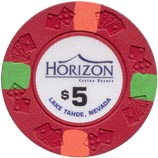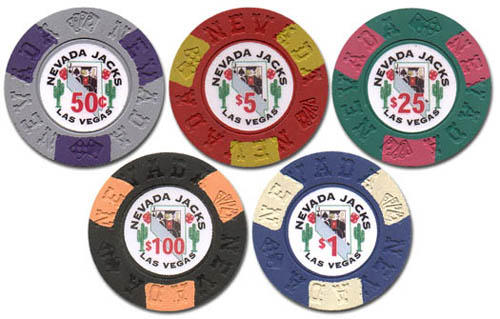Bud designed the 'NEVADA' mold in 1965 and the 'DIECARD' mold in 1971. The Burt Co. had the molds made for BJ and then made chips to his orders. While BJ owned the molds they would have resided at the Burt Co. Bud Jones never actually made chips from the molds. It is believed the molds cost around $40,000 each to make at that time.

In its correct orientation the NEVADA mold consists of two instances of the word 'NEVADA' separated by 'four aces' at the 9 o'clock position and '2 and 5 dice' at 3 o'clock. Chips from this mold are medal aligned so the position of the aces and dice will be reversed on the back of the chip. The DIECARD mold consists of 4 repetitions of the 'four aces' separated by 4 repetitions of the '2 and 5 dice'. Chips from this mold are coin aligned and therefore the same on both sides. Both molds were used for both inlay and hot-stamp chips. Burt Co./Atlantic Standard chips are rarely found with inlays or hot-stamps perfectly aligned. Bill Borland however took trouble to align most of his hot-stamp chips correctly when he later used the molds to make counterfeit chips.
Unfortunately we have no records to confirm BJ supplied any out of state orders on the NEVADA mold. The long debated but still unidentified EP chips shown below may well have been the only ones. The chips may of course have been from Ernie Primm's Club in Reno but the order was not shipped to Nevada. More than likely they were for either Ernie Primm's Club in Gardena, CA, or the nearby Embassy Palace Club which Primm also operated. Regardless of their use, Primm's own history, which will doubtless be debated once more, dictates that these must have been among the earliest chips produced on the mold. Use of the DIECARD mold was more widespread, both within and outside the US.

Other early uses of the two molds, with hotstamp and inlay, are illustrated below. Bud stopped selling chips on the two molds in 1980 except for re-orders and special requests. The last BJ order for inlayed NEVADA mold chips was for Circus Circus in 1978. The $1 chip from that last order, known to differ slightly in color from previous orders/re-orders is also shown.

In 1973, Bud started making his own plastic coin inlay chips, using a new incused DIECARD mold. He designed them so that he could sell his own line which was different to others. Sadly, as these chips have really stood the test of time, he never managed to crack the empire of Paul Endy's Paulson. Paul told everyone that Bud's coin inlays were too slippery for dealers to cut. They believed him and most never gave them a chance. Most of BJ's Las Vegas business appeared to remain within the Hughes controlled casinos, where he was already selling tables, dice and other gaming supplies. As a further new line, he started making his own '8 suit' clay chips in 1980. Here are some examples of his earliest coin inlays.

In the late 1980's, BJ introduced a smooth, non-incused coin inlay chip, which was made on similar DIESUITS & DIE4SUIT molds. These chips remain in use in many casinos today and are still produced on request.
The Burt Co. was owned by the Burt family from 1936 to 1985 when they sold out to Delta Reality. John Kendall then acquired them later the same year and continued running the company until it went out of business in 1988 when he founded Chipco to manufacture his preferred 'Protec' chips and sold the Burt Co. assets to Jim Blanchard. Burt Co. resumed manufacturing under the name of Atlantic Standard.
Bill Borland bought the rights to the two molds from Bud Jones around 1991. The molds themselves remained with Jim Blanchard/Atlantic Standard who made chips and blanks on the dies to Borland's orders. Borland made his fantasy commemorative chips on the NEVADA mold and produced a number of counterfeit hotstamp chips on both molds. He did produce 3 genuine chips to order for the Hotel Nevada, Battle Mountain. He also made value and non-value chips for other establishments inside and outside Nevada. It has not been possible to confirm whether these chips were actually produced to fulfil orders and were in use at the relevant casinos or otherwise. The hotstamps on these chips were not properly aligned. There are some examples below.

When Borland died Jerry Wall came into control of his assets. A couple of years later Jim Blanchard (Atlantic Standard Molding, formerly Burt Co.) bought the rights to the molds from Wall/Borland's estate and made the Nevada Jacks' chips shortly afterwards. Blanchard continued making and selling chips on the DIECARD mold. He sold the NEVADA mold to 'nevadajacks.net' and these chips are now being manufactured by the Blue Chip Co. In late 2004, Blanchard obtained a license to sell within Nevada and manufactured this new $5 Horizon, Lake Tahoe house chip. It was the only denomination made. In 2013 David Spragg & David Sarles bought ASM and continue to produce chips on the DIECARD mold under the Classic Poker Chips name.

Nevada Jacks chips produced on the NEVADA mold are shown below.

Jim Blanchards chips

The recent chips from Blue Chip co.
Bud Jones died in 2001 and Bourgogne et Grasset (B&G) bought the Bud Jones Co. In 2002 B&G and the Bud Jones Co. merged with Paul-Son Gaming to become the world's largest casino supply company. They changed their name to Gaming Partners International in August 2004.
Thanks in particular to Gene Trimble who carried out all the original research, and to James Campiglia, Allan Myers and Jim Blanchard for their contributions.
I welcome your comments by email.